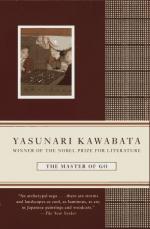|
This section contains 6,342 words (approx. 22 pages at 300 words per page) |

|
SOURCE: "Dialectics and Change in Kawabata's The Master of Go," in Modern Language Studies, Vol. XVI, No. 4, Fall, 1986, pp. 9-21.
In the following essay, Pilarcik asserts that Kawabata's "The Master of Go … captures the poignantly beautiful fading of an era as Japan enters the modern age."
The works of the Nobel Prize winning author, Yasunari Kawabata, are noted for their delicate, wistful beauty and haunting lyricism. They express the essence of the Japanese soul, but also draw on the universality of human experience. The Master of Go, one of Kawabata's most elegiac novels, captures the poignantly beautiful fading of an era as Japan enters the modern age. The narrative is based on the 1938 championship Go match between the aging Master Shusai and his youthful challenger, Kitani Minoru, known as Otaké in the novel. With the defeat and death of the aristocratic Master, the past gives way to the...
|
This section contains 6,342 words (approx. 22 pages at 300 words per page) |

|


